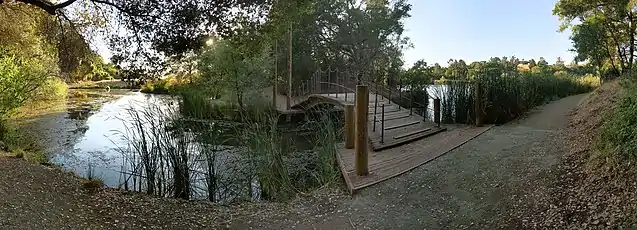Foothills Park
Foothills Park is a 1,400-acre (570 ha) park and nature preserve in the Santa Cruz Mountains of California within the city of Palo Alto. From 1969 until 2020, only residents or city employees of Palo Alto and their guests had lawful access to it, a restriction that has sparked "decades-long" controversy and a 2020 ACLU lawsuit.[1][2][3][4][5][6] The park was opened to the general public on December 17, 2020.[7][8]
| Foothills Park | |
|---|---|
.jpg.webp) The entrance to Foothills Park from Page Mill Road | |
| Coordinates | 37.354°N 122.185°W |
| Area | 1,400-acre (570 ha) |
| Created | 1965 |
| Operated by | Palo Alto |
Geography
The park is located in Palo Alto in the eastern foothills of the Santa Cruz Mountains, bordered on most of its eastern boundary by Page Mill Road. To the north and the lowlands is the Arastradero Preserve also owned by Palo Alto and to the south is Los Trancos Open Space Preserve owned by the Midpeninsula Regional Open Space District. The small Foothills Open Space Preserve also owned by the district is adjacent for part of the east side. Los Trancos Creek is the southwestern boundary of the park and is joined south of the park by Buckeye Creek which flows through the park. The damming of a tributary of Buckeye Creek created Boronda Lake.
The park contains nearly one tenth of all land in Palo Alto.[3] About 90 acres (36 ha) of the park are developed with amenities including a large grassy field, picnic sites, a walk-in, tent-only campground, and a nature interpretive center. Boronda lake is used for fishing, rowing, and canoeing. The park also has 15 miles (24 km) of trails.[1]
The Bay-to-Ridge Trail, which when complete will link the Palo Alto Baylands Nature Preserve to the Bay Area Ridge Trail, runs through the park connecting Arastradero Preserve and Los Trancos Open Space. Non-Palo Alto residents can use this trail even though it is within the park.[9][10]
History
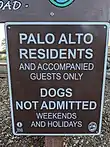
Most of the land for the park was bought from Russel V. Lee, a founder of the Palo Alto Medical Clinic (now Palo Alto Medical Foundation), who offered, in 1958, 1,294 acres of his land at $1,000 an acre ($1.3 million total) to the city to preserve as open space.[11] The total cost was high so Palo Alto put it to a citywide vote in 1959 which passed with 62% of the voters supporting buying the land. The council also asked the neighboring communities of Portola Valley and Los Altos Hills to share in the cost, but they declined. Santa Clara County offered to cover about 40% of the cost ($500,000) in 1964, on the condition that the park be opened to all, but Palo Alto declined.[12]:16 The park opened on June 19, 1965, and the restriction limiting access to Palo Alto residents and their guests was put into place in 1969.[13]:1 In 2005, the county provided $2 million in grant funding to go towards the purchase of 13 additional acres of adjacent land, in exchange for which Palo Alto allowed anyone (nonresidents included) to freely pass through that area and enter Foothills Park, on trails from Arastradero Preserve.[13]:2 It is a misdemeanor for a nonresident to enter the park, unless they are traveling through on specific trails on foot.[13]:5 Enforcement is limited due to budget constraints; the gate is unstaffed on non-holiday weekdays[14] and some weekends in the winter.[13]:5 The city also limits the total number of visitors at one time to 1,000 (approximately 370 vehicles).[15]
Activists painted "DESEGREGATE" outside the front gate in July 2020, in protest of the policy that limits access to residents of Palo Alto and their guests. The policy does not discriminate by race, but they believe it "is closely tied to racist practices of the past".[16][17] In August 2020, the City Council voted to run a one-year pilot study that would open the nature preserve for limited permits to non-residents on a "revenue-neutral" basis, which in practice means a minimal ($6) entry charge "to recover a portion of the expenses associated with the existing cost of staffing the entry gate". Upon completion of the pilot study, the issue of whether or not to open the preserve to the general public will be placed on the ballot so that the residents of Palo Alto can vote on the issue.[13]
In September 2020, the ACLU filed a lawsuit on behalf of the local NAACP, calling the restriction "unconstitutional".[3][6][5] The lawsuit contends that the policy "infringes on the plaintiffs’ fundamental rights of freedom of movement, freedom of speech and freedom of assembly".[3]
Due to the lawsuit, on November 3, 2020 the city council agreed to rescind the policy by a 5–2 vote.[15] The limit on number of visitors will be temporarily lowered to 750.[15] On November 16, the decision was finalized to open the park on December 17, 2020.[18][19] After the first 90 days, visitation limits will be raised from 750 per day to 1000 per day, with no entrance or parking fee for the time being.[18]
Gallery
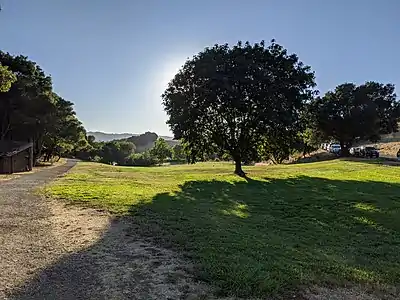 The view from the main entrance
The view from the main entrance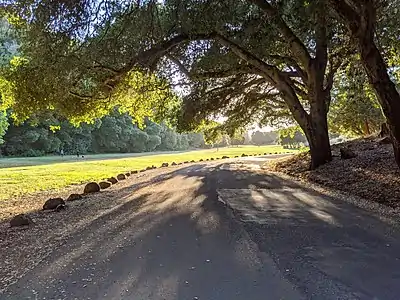 Las Trampas Valley
Las Trampas Valley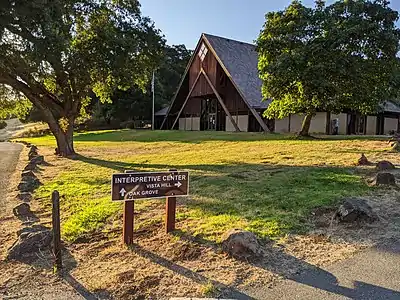 The interpretive center
The interpretive center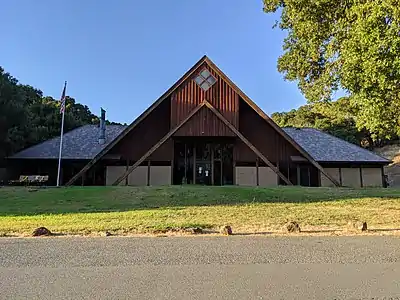 The interpretive center
The interpretive center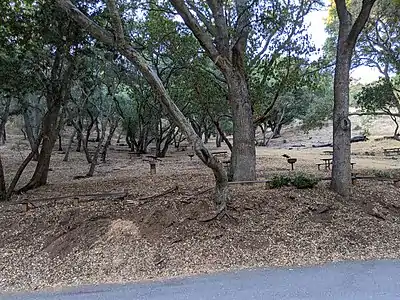 There are over fifty picnic tables in the park[lower-alpha 1]
There are over fifty picnic tables in the park[lower-alpha 1]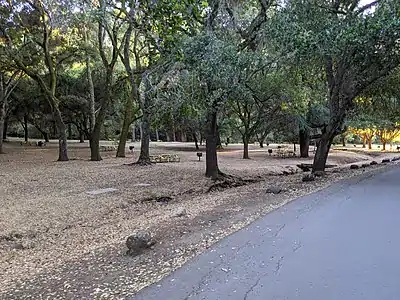 Orchard Glen[lower-alpha 2]
Orchard Glen[lower-alpha 2]
Notes
- There are eighteen picnic tables in the Oak Grove picnic area, which requires advance reservations.[20] There are ten picnic tables in this image, and twenty seven immediately visible in Orchard Glen, for a total of 55.
- The caution tape is because of COVID-19
References
- "City of Palo Alto, CA - Foothills Park". www.cityofpaloalto.org. Retrieved 10 November 2019.
- Cabanatuan, Michael (22 April 2019). "Quirky law keeps pristine Palo Alto park restricted to residents". SFChronicle.com. Retrieved 10 November 2019.
- Toledo, Aldo (15 September 2020). "ACLU sues Palo Alto over 'unconstitutional' restrictions at residents-only park". The Mercury News. Retrieved 16 September 2020.
- "ACLU Sues Palo Alto Over Residents-Only Access To Foothills Park". CBS SF Bay Area. 2020-09-15. Retrieved 2020-09-16.
- "Lawsuit Demands City of Palo Alto Cease Its Discriminatory Policy of Blocking Non-Residents from Use of Public Park". ACLU. 15 September 2020. Retrieved 16 September 2020.
- Cabanatuan, Michael (15 September 2020). "ACLU sues Palo Alto over residents-only park". SF Chronicle. Retrieved 16 September 2020.
- Bradshaw, Kate (18 December 2020). "No longer exclusive, Foothills Park welcomes residents from outside Palo Alto for the first time". Palo Alto Online. Retrieved 21 December 2020.
- "Palo Alto Foothills Park Opens to the Public After Longtime Restrictions for Residents-Only". NBC Bay Area. NBC. 19 December 2020. Retrieved 21 December 2020.
- Trout, Becky (29 July 2008). "From the Bay to Skyline Ridge". www.paloaltoonline.com. Retrieved 10 November 2019.
- "Palo Alto Open Space Trail Map". www.cityofpaloalto.org. 24 December 2010. Retrieved 12 November 2019. The linked pdf on this page includes a map of the Bay-to-Ridge trail and of Foothills Park.
- Sorman, Audra (30 June 2013). "Foothills Park: Still (mostly) just for Palo Altans". Palo Alto Online. Retrieved 10 November 2019.
- "NAACP vs. Palo Alto complaint" (PDF). Retrieved 17 November 2020.
- "Palo Alto August 3 2020 city council agenda".
- Sheyner, Gennady. "Palo Alto moves to expand access to 'residents-only' Foothills Park". www.paloaltoonline.com. Retrieved 2020-09-08.
- Sheyner, Gennady (3 November 2020). "Palo Alto strikes ban on nonresidents at Foothills Park". www.paloaltoonline.com. Retrieved 3 November 2020.
- Sheyner, Gennady (2020-07-07). "Activist group calls on city to 'desegregate' Foothills Park". Palo Alto Weekly.
- Ingram, David (23 August 2020). "An exclusive park in the heart of Silicon Valley faces a racial justice reckoning". NBC News. NBC. Retrieved 8 September 2020.
- Winslow, Megan (17 November 2020). "Paly council affirms opening Foothills Park". Los Altos Online. Los Altos Town Crier. Retrieved 26 November 2020.
- Stienstra, Tom (12 November 2020). "How to enjoy Palo Alto's Foothills Park, which is finally opening to the public". SF Chronicle. Retrieved 26 November 2020.
- "Oak Grove Group Picnic Area". City of Palo Alto. 11 May 2020. Retrieved 21 August 2020.



